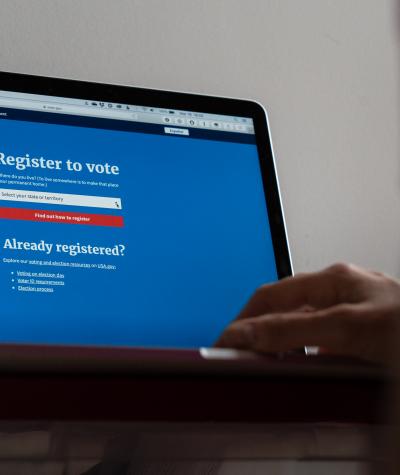By Kevin Muench, a Summer 2021 CLC intern
During 2020, the U.S. held elections for some 470 seats in Congress and 5,875 state legislators, totaling over 159.7 million votes cast – a historic turnout for U.S. elections. But despite the record turnout, many voters faced barriers to participating due to difficulties registering to vote.
To make the promise of democracy real for us all, the U.S. should make registering to vote equal and more accessible. There are a number of national standards that the U.S. could adopt to do so, such as automatic voter registration, same-day registration and online registration.
Each of these policies holds the promise of guaranteeing that Americans have a say in key decisions that impact our lives.
With automatic voter registration (AVR), state governments register eligible Americans to vote automatically when they interact with a government agency like the DMV, unless they opt out. These agencies use existing, secure information to determine eligibility before notifying eligible, unregistered Americans that they’ll be registered to vote.
Oregon became the first state to adopt AVR in 2016, and since then, 18 states and the District of Columbia have followed suit. AVR has been shown to increase overall registration and increase the economic diversity among voters.
For example, in Oregon, a state with a median income of $51,000, 39% of the new voters registered through AVR had median incomes below $45,000.
And Georgia added more than 681,000 voters to their rolls three years after implementing AVR. A study by the Center for American Progress found that “if every state implemented Oregon’s model of AVR, more than 22 million registered voters could be added to state voter rolls in just the first year.”
Same-day voter registration (SDR) enables Americans to register to vote at any time, including on Election Day. Same-day registration is a transparent process we can trust that has been associated with increased turnout. In the 2012 presidential election, average turnout was over 10% higher in SDR states than in non-SDR states.
SDR also increases registration within historically disenfranchised communities. In 2008, North Carolina experienced its first presidential election with SDR and Black voters accounted for 36% of the same day registrants, despite being only 21% of the overall voting-age population.
Online voter registration enables Americans to register to vote online, through a secure and accessible portal. Voters can also check and update their registration records to ensure they can exercise their freedom to vote without being held up by something as small as an out-of-date address.
Forty states and the District of Columbia currently or will soon offer online voter registration, which studies have shown increases voter roll accuracy and boosts registration rates.
It is critical that we adopt these policies into national standards for voting access because, unfortunately, Americans do not have equal access to registration. In fact, the U.S. has noticeable race and wealth-based gaps in registration.
During the 2008 presidential election, the registration gap between low and high-income voters was over 19%. And new barriers to registration are being erected every day that run the risk of denying our freedom to vote.
But these policies hold the potential to overcome deliberate barriers built by extremist politicians, make voting more accessible and ensure that the promise of democracy is real for us all.
For more information on the barriers Americans are facing to voter registration, attacks on voter registration and how the U.S. can modernize registration, please visit Campaign Legal Center’s DemocracyU.
